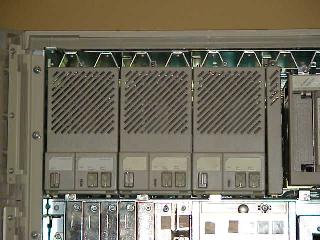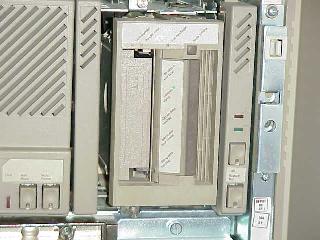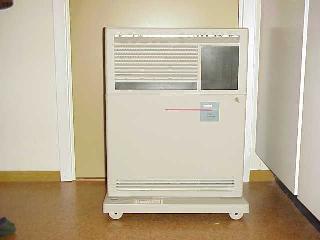


It's configuration is as follows:
| CPU | KA670-A V3.4 | Rigel |
|---|---|---|
| Clock Speed | 36 MHz | - |
| VUPS | 8.0 | - |
| BUS | QBUS, DSSI | - |
| Memory | 160 MB | - |
| ### | ##-##-##-##-##-## | 192.168.0.41 |
| DIA4 | RF72 | 1 GB |
| DIA5 | RF72 | 1 GB |
| DIA13 | RF72 | 1 GB |
| MUA0 | TK70 | 296 MB |
This is the first VAX 4000 machine released in 1987. It uses the Rigel processor which is the successor the the CVAX chip used in the previous line of machines from Digital, the MicroVAX 3000 series (to which I don't consider the MicroVAX 3100 as beloninging, but rather the 3400, 3600 and 3900 etc.).
All these are QBUS machines and have CPU name designations in a series originating from the MicroVAX I (KA620) over the MicroVAX II (KA630) to the MicroVAX 3000 series (KA640, KA650 and KA655) to in this case the VAX 4000-300 (KA670). The KA660 was released later and based on a more highly integrated version of the CVAX chip (SOC) to produce the more limited VAX 4000-200 model.
Later this series was continued into VAX 4000-400/50x/70x machines all looking like the VAX 4000-300 and the VAX 4000-10x series which are physically much smaller (similar to MicroVAX 3100 machines) but with other similarities to the VAX 4000 series such as DSSI interface and the ability to attach an external QBus expansion cabinet.
DSSI is a disk bus used in (amongst others) VAX 4000 series machines. DSSI is a differential proprietary version of SCSI, and uses special Digital DSSI disks called RFxx. Where xx usually starts with the number three for half height 5.25" disks and with a seven for full height disks. In the VAX 4000-300 these disks must be mounted in casettes, that can be easily pushed inplace of the disk cabinet. After a casette has been pushed in a cover contining the necessary buttons and indicators is placed in front of it. Thus the necessary wiring that has to be made is kept at a minimum.
The VAX 4000-300 cabinet (called BA440) provides space for up to a maximum of four internal DSSI drives. These can be either RF series disks or TF series DSSI DLT tapes. One of the drive bays contains an alternative connection for connecting to a TQK50/TQK70 controller instead of connecting to the DSSI bus. Thus a TK50 or TK70 drive may be used with the system.
If connection to SCSI devices is required either the limited, low performance, solution of installing a KZQSA SCSI adapter on the QBus can be used or a high performance SCSI adapter can be connected through the DSSI bus. The QBUS solution is only supported for CD-ROM and Tape applications under OpenVMS (under Ultrix it is supported for Disk operations as well, atleast in Ultrix/RISC).
Despite the, even by 1987 standards, slow QBUS system in the machine good throughput can be reached by integrating both ethernet and DSSI adapters directly on the CPU module (a design which was pioneered already by the KA640 CPU module used in the MicroVAX 3300/3400 machines). Further memory boards are connected on a dedicated higher performing memory bus. Up to four memory boards can be inserted in the system, each with a capacity of either 32 or 64 MB. My system contains one 64 MB board and three 32 MB boards giving a total of 160 MB memory.